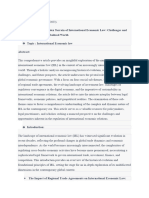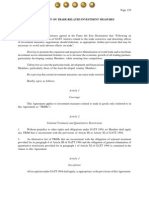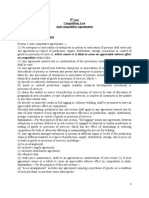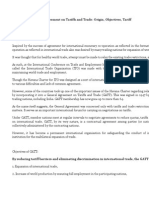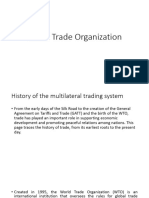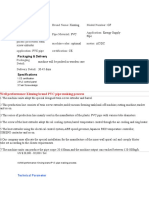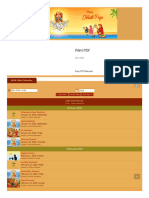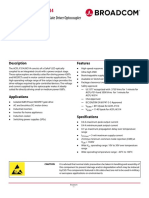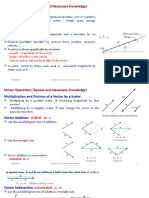Gatt and Wto
Gatt and Wto
Uploaded by
Rhythm GurjarCopyright:
Available Formats
Gatt and Wto
Gatt and Wto
Uploaded by
Rhythm GurjarOriginal Description:
Copyright
Available Formats
Share this document
Did you find this document useful?
Is this content inappropriate?
Copyright:
Available Formats
Gatt and Wto
Gatt and Wto
Uploaded by
Rhythm GurjarCopyright:
Available Formats
GATT AND WTO
BACKGROUND: THE TWO GATTS The original General Agreement on Tariffs and Trade, now referred to as GATT 1947, provide basic rules of the multilateral trading system from 1 January 1948 until the WTO entered into force on 1 January 1995.These rules, which dealt only with trade in goods, were supplemented and modified by many further legal instruments adopted over the 47 years between 1948 and 1995, as a result of multilateral negotiations, protocols of accession, waivers and other decisions. The General Agreement on Tariffs and Trade (GATT) From 1948 to 1994, the General Agreement on Tariffs and Trade (GATT) provided the rules for much of world trade and presided over periods that saw some of the highest growth rates in international commerce. It seemed well-established, but throughout those 47 years, it was a provisional agreement and organization. The original intention was to create a third institution to handle the trade side of international economic cooperation, joining the two Bretton Woods institutions, the World Bank and the International Monetary Fund The Uruguay Round, Passing from GATT to WTO The last and largest GATT round, was the Uruguay Round which lasted from 1986 to 1994 and led to the WTOs creation. Whereas GATT had mainly dealt with trade in goods, the WTO and its agreements now cover trade in services, and in traded inventions, creations and designs (intellectual property).
What is the World Trade Organization?
The World Trade Organization (WTO) deals with the rules of trade between nations at a global or nearglobal level. But there is more to it than that. Above all, its a negotiating forum Essentially; the WTO is a place where member governments go, to try to sort out the trade problems they face with each other. The first step is to talk. The WTO was born out of negotiations, and everything the WTO does is the result of negotiations. Its a set of rules At its heart are the WTO agreements, negotiated and signed by the bulk of the worlds trading nations. These documents provide the legal ground-rules for international commerce. They are essentially contracts, binding governments to keep their trade policies within agreed limits. And it helps to settle disputes This is a third important side to the WTOs work. Trade relations often involve conflicting interests. Agreements, including those painstakingly negotiated in the WTO system, often need interpreting. The most harmonious way to settle these differences is through some neutral procedure based on an agreed legal foundation. That is the purpose behind the dispute settlement process written into the WTO agreements.
Born in 1995, but not so young The WTO began life on 1 January 1995, but its trading system is half a century older. Since 1948, the General Agreement on Tariffs and Trade (GATT) had provided the rules for the system.
The Agreements
The WTO Agreements cover goods, services and intellectual property. They spell out the principles of liberalization, and the permitted exceptions. They include individual countries commitments to lower customs tariffs and other trade barriers, and to open and keep open services markets. The agreements for the two largest areas goods and services share a common three-part outline, even though the detail is sometimes quite different. They start with broad principles: the General Agreement on Tariffs and Trade (GATT) (for goods), and the General Agreement on Trade in Services (GATS). (The third area, Trade-Related Aspects of Intellectual Property Rights (TRIPS), also falls into this category although at present it has no additional parts.) They come extra agreements and annexes dealing with the special requirements of specific sectors or issues. Finally, there are the detailed and lengthy schedules (or lists) of commitments made by individual countries allowing specific foreign products or service-providers access to their markets.
The Principles
The trading system should be Without discrimination a country should not discriminate between its trading partners (giving them equally most-favoured-nation or MFN status); and it should not discriminate between its own and foreign products, services or nationals (giving them national treatment). Freer barriers coming down through negotiation. Predictable foreign companies, investors and governments should be confident that trade barriers (including tariffs and non-tariff barriers) should not be raised arbitrarily; tariff rates and market-opening commitments are bound in the WTO. More competitive discouraging unfair practices such as export subsidies and dumping products at below cost to gain market share. More beneficial for less developed countries giving them more time to adjust, greater flexibility, and special privileges.
Trade Without Discrimination
1. Most-favoured-nation (MFN): treating other people equally Under the WTO agreements, countries cannot normally discriminate between their trading partners. Grant someone a special favour (such as a lower customs duty rate for one of their products) and you have to do the same for all other WTO members. 2. National treatment: Treating foreigners and locals equally imported and locallyproduced goods should be treated equally at least after the foreign goods have entered the market. The same should apply to foreign and domestic services, and to foreign and local trademarks, copyrights and patents. National treatment only applies once a product, service or item of intellectual property has entered the market. Therefore, charging customs duty on an import is not a violation of national treatment even if locally-produced products are not charged an equivalent tax.
PRESS RELEASE WTO 2013
Brand Evolution in Communication [Cadbury India 1948 to 2013] Cadbury is a brand that all of us have literally grown up with. Though it has been immensely successful in its operations in the USA, UK, Australia, etc. from the 1800s, it entered the Indian market only in 1948. Since then, it has used a variety of strategies and a string of ad campaigns to reach out to the Indian consumer. Initially, Cadbury ads targeted children they showed a loving father bringing chocolates home for the children as a surprise. The ads were formulated keeping in mind the Indian society then, where the children didnt have money with themselves to buy sweets and chocolates. With this, Cadbury was able to capture a substantial part of its target segment the kids. Next, it launched its famous ad where a teenage girl watches her friend play cricket and jumps into the cricket field, eating a Cadbury chocolate as soon as he hits a century. Another advertisement showed a prospective bride with mehndi on her hands, prying open the wrapping of Cadbury chocolate with her elbows. It showed that teenagers too can enjoy the Cadbury chocolate. Next came the much talked about ad featuring Cyrus Broacha. It showed people from all age groups a housewife in her 40s, a couple well into their 60s, and a teenager enjoying the chocolate as Cyrus sang in the background Khaane walon ko khaane ka bahaana chahiye. In this way, Cadbury created inroads into all possible age groups. Post this, Cadbury changed its strategy. Having tapped all age-groups, it wanted to project Cadbury chocolates as a meetha thereby trying to eat into the market of traditional Indian sweets. Advertisements were doled out showing Cadbury chocolate being enjoyed at every possible instance1- before a good task (Shubh kaam ke aarambh se pehle), 2- after dinner (Khaane ke baad meethe mein kya hai), 3-on payday (Khush hai zamaana aaj pehli taariq hai), 4-after passing exams (Pappu pass ho gaya) or 5-while just having a good day (Main khush hun aaj khamakha). Apart from this, Cadbury always comes out with special advertisements before important festivals like Diwali (toh iss Diwali aap kise khush karenge) and Rakshabandhan (Cadbury Celebrations- Pyar ka shagun). Cadbury was projected as the chocolate to eat on important as well as happy occasions.
Rhythm Gurjar TYBMM- Ad41
You might also like
- Pierson and Fairchild - S Principles - Techniques of Patient Care 6th100% (3)Pierson and Fairchild - S Principles - Techniques of Patient Care 6th1,044 pages
- Legal Framework For Infrastructure - Its Impact On Construction IndustryNo ratings yetLegal Framework For Infrastructure - Its Impact On Construction Industry13 pages
- On Residential Status and Scope of Total Income100% (3)On Residential Status and Scope of Total Income72 pages
- Considerations For Choosing HP Agentless ManagementNo ratings yetConsiderations For Choosing HP Agentless Management8 pages
- Int Trade Law Special Back Paper ProjectNo ratings yetInt Trade Law Special Back Paper Project19 pages
- EMERGING ISSUES in Competition Law in IndiaNo ratings yetEMERGING ISSUES in Competition Law in India11 pages
- Trade Related Investment Measures: Ankaj Mohindroo Mba-Ib UBSNo ratings yetTrade Related Investment Measures: Ankaj Mohindroo Mba-Ib UBS35 pages
- Legal Aid Cell The Northcap University Research On RTINo ratings yetLegal Aid Cell The Northcap University Research On RTI11 pages
- Anticompetitive Agreements Under The Competition ActNo ratings yetAnticompetitive Agreements Under The Competition Act16 pages
- Index: Economics Development and Competition Policy 4 Competition and Competition Policy InterplayNo ratings yetIndex: Economics Development and Competition Policy 4 Competition and Competition Policy Interplay20 pages
- From Gatt To Wto: Irina Gabriela Rădulescu, Bogdan DumbrăvescuNo ratings yetFrom Gatt To Wto: Irina Gabriela Rădulescu, Bogdan Dumbrăvescu11 pages
- Symbiosis International (Deemed University) Pune Symbiosis Law Scool, PuneNo ratings yetSymbiosis International (Deemed University) Pune Symbiosis Law Scool, Pune17 pages
- Udita Isil project-International-Trade-Law-ProjectNo ratings yetUdita Isil project-International-Trade-Law-Project19 pages
- Special and Differential Treatment For Developing Countries: by Thomas FritzNo ratings yetSpecial and Differential Treatment For Developing Countries: by Thomas Fritz47 pages
- Agreement On Trade-Related Investment MeasuresNo ratings yetAgreement On Trade-Related Investment Measures6 pages
- Income From Property Held For Charitable or Religious Purposes Rohit Ranjan CnluNo ratings yetIncome From Property Held For Charitable or Religious Purposes Rohit Ranjan Cnlu19 pages
- Dr. Ram Manohar Lohia National Law University, Lucknow: International Trade Law Project OnNo ratings yetDr. Ram Manohar Lohia National Law University, Lucknow: International Trade Law Project On22 pages
- The World Trade Organization... The World Trade Organization..No ratings yetThe World Trade Organization... The World Trade Organization..7 pages
- Core WTO Agreements: Trade in Goods and Services and Intellectual PropertyNo ratings yetCore WTO Agreements: Trade in Goods and Services and Intellectual Property49 pages
- Lawtimesjournal - In-R Kempraj Vs MS Barton Sons and CompanyNo ratings yetLawtimesjournal - In-R Kempraj Vs MS Barton Sons and Company3 pages
- Negotiation: 2. GATT: General Agreement On Tariffs and Trade: Origin, Objectives, TariffNo ratings yetNegotiation: 2. GATT: General Agreement On Tariffs and Trade: Origin, Objectives, Tariff6 pages
- World Trade Organisation: Functions of W.T.ONo ratings yetWorld Trade Organisation: Functions of W.T.O12 pages
- International Trade Law Termpaper Topics-1No ratings yetInternational Trade Law Termpaper Topics-13 pages
- Articles of Association Under Companies LawNo ratings yetArticles of Association Under Companies Law8 pages
- THE LABOUR LAW IN UGANDA: [A TeeParkots Inc Publishers Product]From EverandTHE LABOUR LAW IN UGANDA: [A TeeParkots Inc Publishers Product]No ratings yet
- 2026 Odia Calendar, Orissa Calendar For New Delhi, NCT, IndiaNo ratings yet2026 Odia Calendar, Orissa Calendar For New Delhi, NCT, India5 pages
- Mazagon Dock Shipbuilders LTD DRHP - 20190807160934No ratings yetMazagon Dock Shipbuilders LTD DRHP - 20190807160934357 pages
- A New Anti Swing Control of Overhead CranesNo ratings yetA New Anti Swing Control of Overhead Cranes6 pages
- Design For Additive Manufacturing: Minimization of Residual Stress in Metal Additive ManufacturingNo ratings yetDesign For Additive Manufacturing: Minimization of Residual Stress in Metal Additive Manufacturing11 pages
- Performance of A Double-Star Synchronous Generator With Bridge Rectified OutputNo ratings yetPerformance of A Double-Star Synchronous Generator With Bridge Rectified Output7 pages
- Uncovering the Silicon - ΜL914 - Evil Mad Scientist LaboratoriesNo ratings yetUncovering the Silicon - ΜL914 - Evil Mad Scientist Laboratories21 pages
- Efficient Compensation of RF Impairments For OFDM Systems: (Deepaknath - Tandur, Marc - Moonen) @esat - Kuleuven.beNo ratings yetEfficient Compensation of RF Impairments For OFDM Systems: (Deepaknath - Tandur, Marc - Moonen) @esat - Kuleuven.be6 pages
- Pierson and Fairchild - S Principles - Techniques of Patient Care 6thPierson and Fairchild - S Principles - Techniques of Patient Care 6th
- Legal Framework For Infrastructure - Its Impact On Construction IndustryLegal Framework For Infrastructure - Its Impact On Construction Industry
- Considerations For Choosing HP Agentless ManagementConsiderations For Choosing HP Agentless Management
- Trade Related Investment Measures: Ankaj Mohindroo Mba-Ib UBSTrade Related Investment Measures: Ankaj Mohindroo Mba-Ib UBS
- Legal Aid Cell The Northcap University Research On RTILegal Aid Cell The Northcap University Research On RTI
- Anticompetitive Agreements Under The Competition ActAnticompetitive Agreements Under The Competition Act
- Index: Economics Development and Competition Policy 4 Competition and Competition Policy InterplayIndex: Economics Development and Competition Policy 4 Competition and Competition Policy Interplay
- From Gatt To Wto: Irina Gabriela Rădulescu, Bogdan DumbrăvescuFrom Gatt To Wto: Irina Gabriela Rădulescu, Bogdan Dumbrăvescu
- Symbiosis International (Deemed University) Pune Symbiosis Law Scool, PuneSymbiosis International (Deemed University) Pune Symbiosis Law Scool, Pune
- Udita Isil project-International-Trade-Law-ProjectUdita Isil project-International-Trade-Law-Project
- Special and Differential Treatment For Developing Countries: by Thomas FritzSpecial and Differential Treatment For Developing Countries: by Thomas Fritz
- Income From Property Held For Charitable or Religious Purposes Rohit Ranjan CnluIncome From Property Held For Charitable or Religious Purposes Rohit Ranjan Cnlu
- Dr. Ram Manohar Lohia National Law University, Lucknow: International Trade Law Project OnDr. Ram Manohar Lohia National Law University, Lucknow: International Trade Law Project On
- The World Trade Organization... The World Trade Organization..The World Trade Organization... The World Trade Organization..
- Core WTO Agreements: Trade in Goods and Services and Intellectual PropertyCore WTO Agreements: Trade in Goods and Services and Intellectual Property
- Lawtimesjournal - In-R Kempraj Vs MS Barton Sons and CompanyLawtimesjournal - In-R Kempraj Vs MS Barton Sons and Company
- Negotiation: 2. GATT: General Agreement On Tariffs and Trade: Origin, Objectives, TariffNegotiation: 2. GATT: General Agreement On Tariffs and Trade: Origin, Objectives, Tariff
- THE LABOUR LAW IN UGANDA: [A TeeParkots Inc Publishers Product]From EverandTHE LABOUR LAW IN UGANDA: [A TeeParkots Inc Publishers Product]
- 2026 Odia Calendar, Orissa Calendar For New Delhi, NCT, India2026 Odia Calendar, Orissa Calendar For New Delhi, NCT, India
- Mazagon Dock Shipbuilders LTD DRHP - 20190807160934Mazagon Dock Shipbuilders LTD DRHP - 20190807160934
- Design For Additive Manufacturing: Minimization of Residual Stress in Metal Additive ManufacturingDesign For Additive Manufacturing: Minimization of Residual Stress in Metal Additive Manufacturing
- Performance of A Double-Star Synchronous Generator With Bridge Rectified OutputPerformance of A Double-Star Synchronous Generator With Bridge Rectified Output
- Uncovering the Silicon - ΜL914 - Evil Mad Scientist LaboratoriesUncovering the Silicon - ΜL914 - Evil Mad Scientist Laboratories
- Efficient Compensation of RF Impairments For OFDM Systems: (Deepaknath - Tandur, Marc - Moonen) @esat - Kuleuven.beEfficient Compensation of RF Impairments For OFDM Systems: (Deepaknath - Tandur, Marc - Moonen) @esat - Kuleuven.be






















